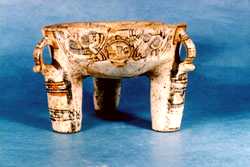Nicaragua
U.S. Protection of Pre-Hispanic Archaeological Materials
I.
U.S. Action
II. Background
III.
Categories of Artifacts Subject to Import Restriction
IV. Import Regulations
V. For More Information
I. U.S. Action
- On June 16, 1999, the Government of the United States of America and the Government of Nicaragua signed an Agreement to place import restrictions on Nicaraguan archaeological materials. The import restrictions went into effect on October 26, 2000 following the conclusion of an exchange of diplomatic notes between the two governments on October 20, 2000.
II. Background
This U.S. action is in response to a request from the Government of the Republic of Nicaragua under Article 9 of the 1970 UNESCO Convention on the Means of Prohibiting and Preventing the Illicit Import, Export and Transfer of Ownership of Cultural Property. Such action assists another country in combating the destruction of archaeological sites and the illicit movement of cultural objects across international boundaries. This enables both countries to address long-term remedies to protect these non-renewable resources for future generations. The U.S. action also further the aims of the 1994 Summit of the Americas action plan to enhance appreciation of indigenous cultures and cultural artifacts through the implementation of cultural property protection agreements.
The widespread looting of sites to provide artifacts for the U.S. and international market prevents future scientific investigation and reconstruction of Nicaraguan history. In the early 1990's, the site of El Ostional near the border with Costa Rica was looted of jade pieces previously unknown in the country before archaeologists could scientifically recover and analyze the materials. Ongoing pillage is documented in a recent newspaper article describing the pillage of a pre-Columbian cemetery site to acquire artifacts to sell locally and abroad (El Nuevo Diario, March 20, 2000). The Nicaraguan archaeological sequence is still largely unknown and looting sites and cemeteries will prevent future scientific investigation and recovery.
III. Categories of Artifacts Subject to Import Restriction
 |
A complete list is published in the Federal Register notice of October 26, 2000. An illustrated list is available in the Nicaragua Image Collection. |
| Vallejo Polychrome Tripod Bowl. Photograph courtesy of Fred Lange. |
Material includes categories of pre-Columbian archaeological materials from 8000 B.C. to 1550 A.D. including, but not limited to: ceramic polychrome vessels, ceramic seals, beads and spindle whorls; stone statues, vessels, grinding stones, petroglyphs, mace heads, small greenstone objects, jewelry, and chipped stone tools; gold decorative ornaments; and pierced shell beads.
IV. Import Regulations
Objects listed in the Federal Register notice may enter the U.S. if they have an export permit issued by Nicaragua or verifiable documentation that they left Nicaragua prior to the effective date of the restriction: October 26, 2000.
Under the 1973 Pre-Columbian Monumental or Architectural Sculpture or Murals Statute, monumental or architectural sculpture or murals may be imported into the U.S. only with an export license issued by the country of origin or verifiable documentation that it left the country of origin prior to June 1, 1973.
V. For More Information
| United
States International Cultural Property Protection |
Nicaragua
Dirección de Patrimonio Cultural Instituto Nicaraguense de Cultura Palacio Nacional de la Cultura Managua, Nicaragua Tel: (505) 222-4477 |
Home | Site Index | Site Search | Disclaimer & Credits | Contact Us | Back To Top
Revised: October 19, 2001
2000 Federal Register Notice (html) (text)